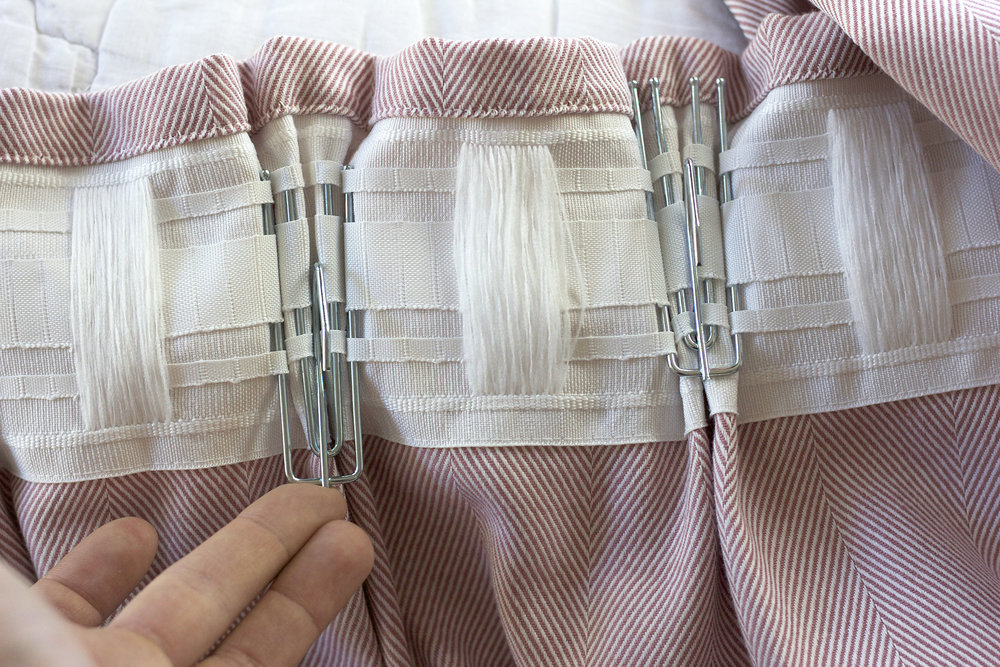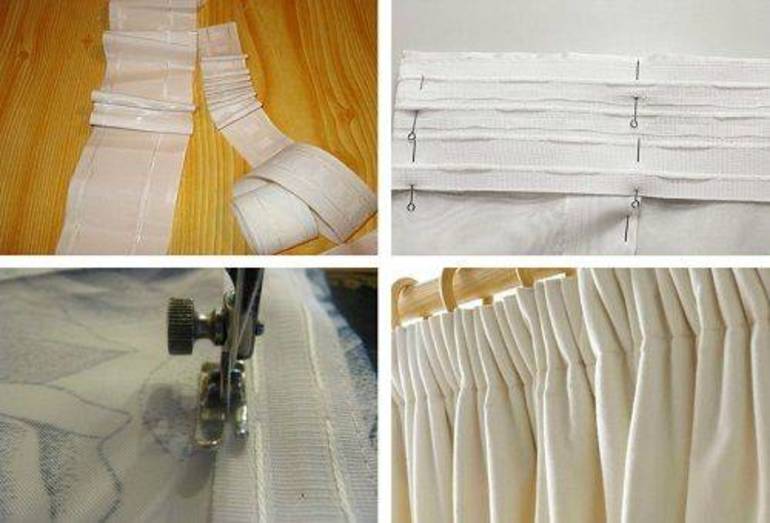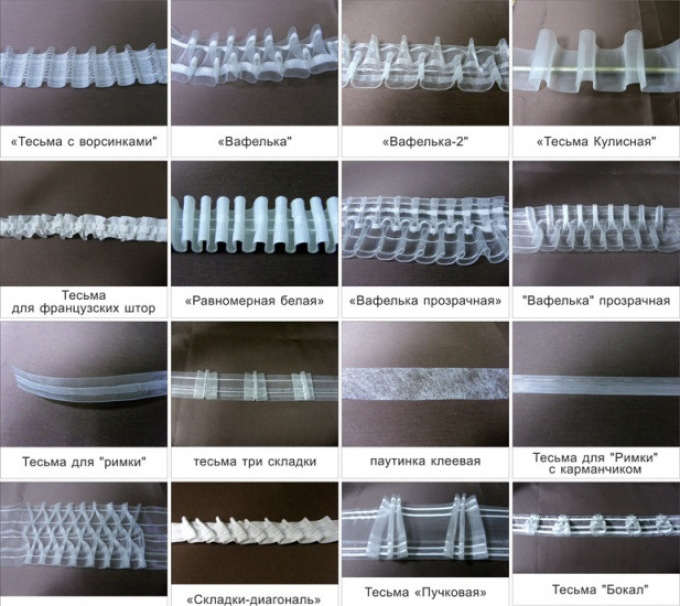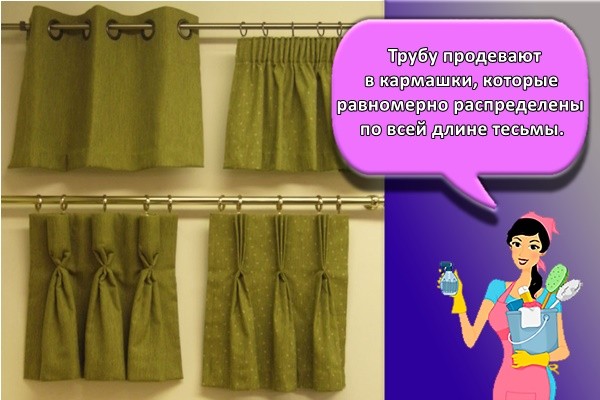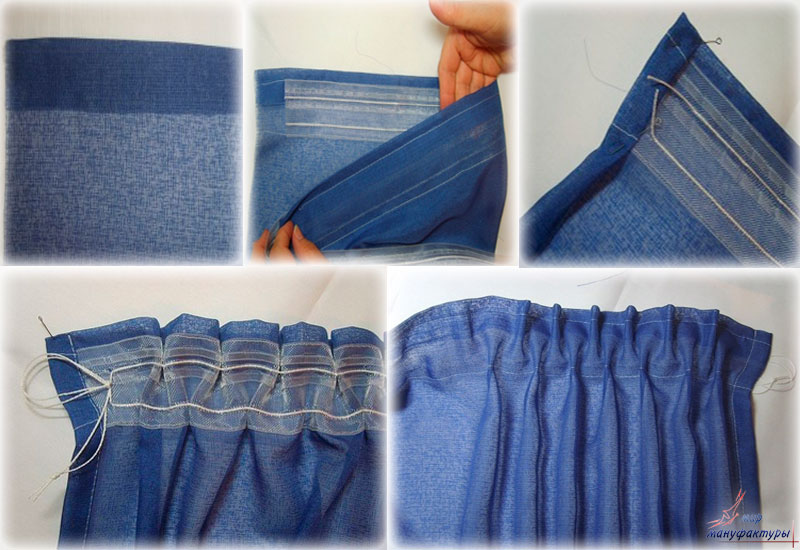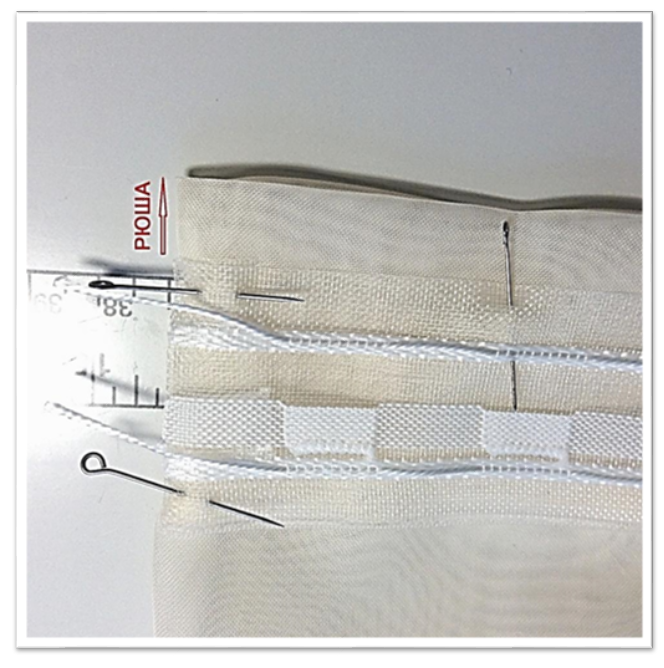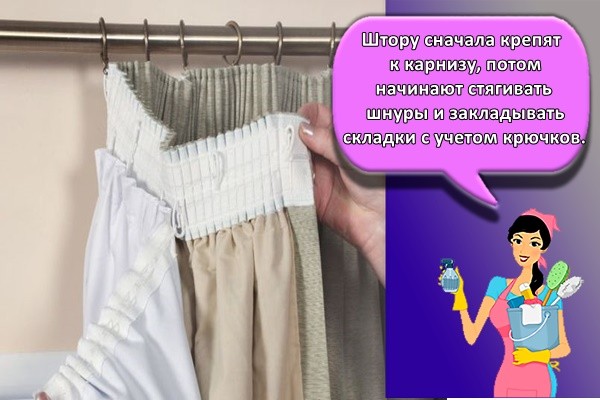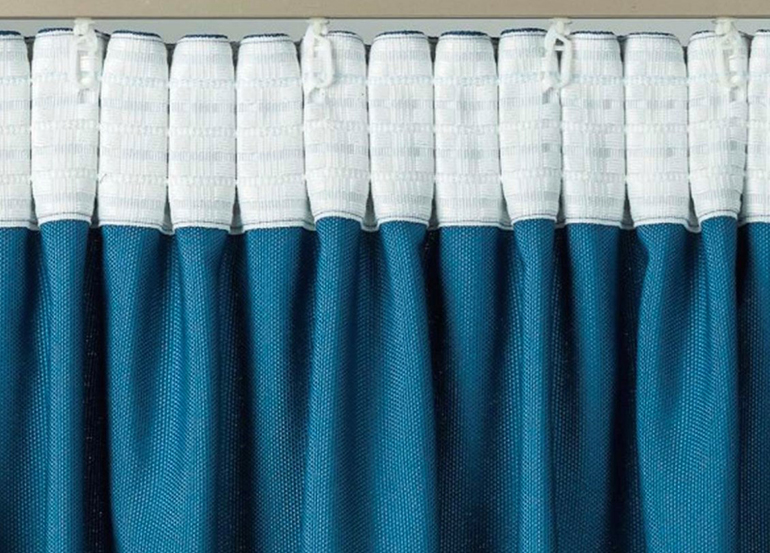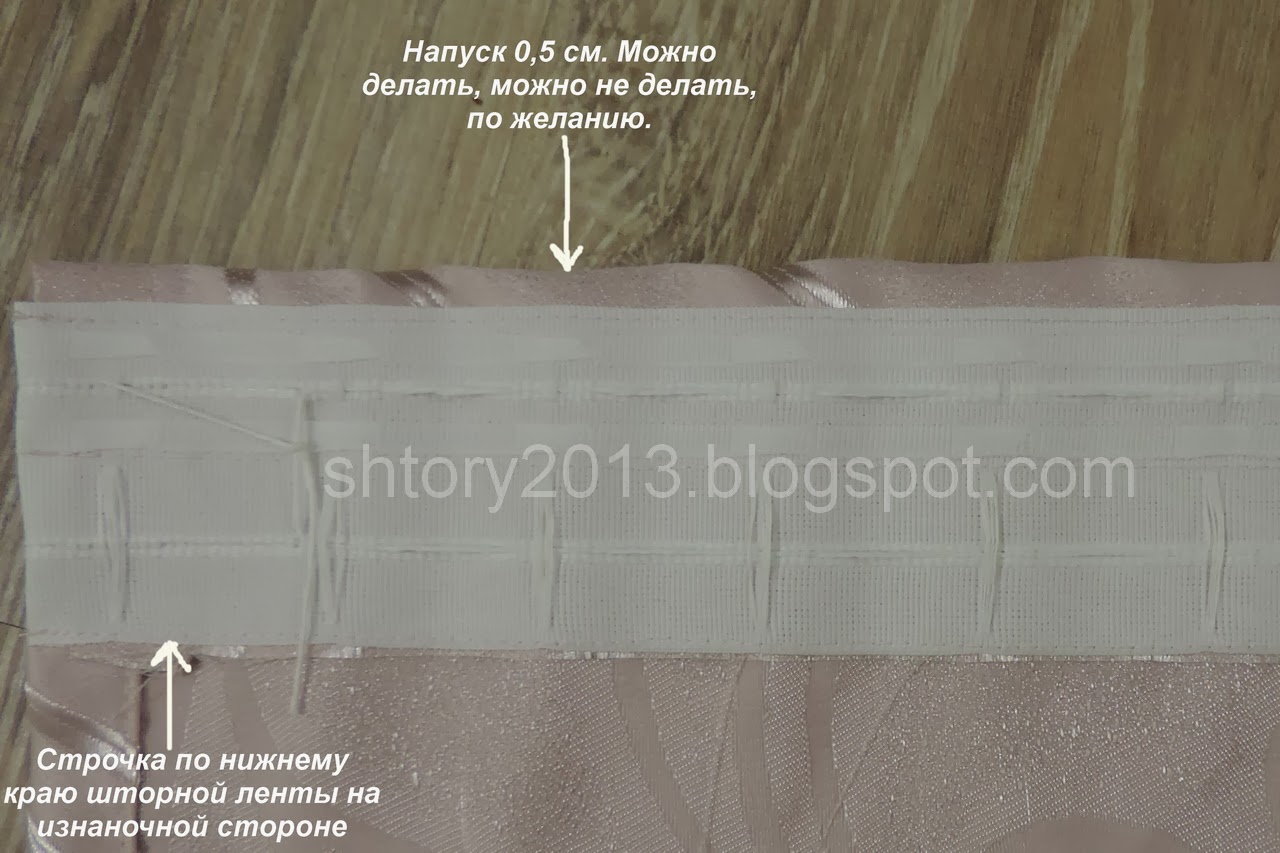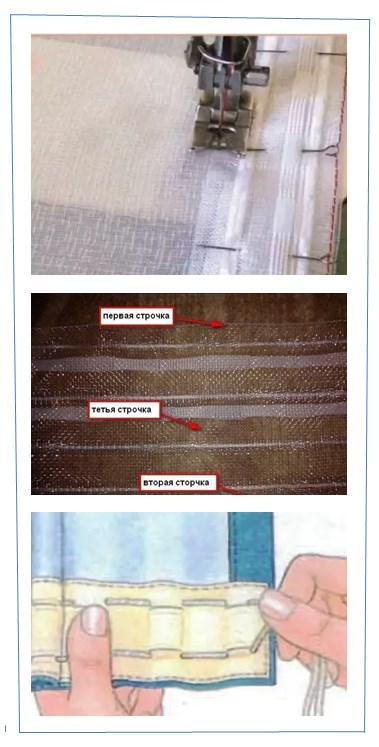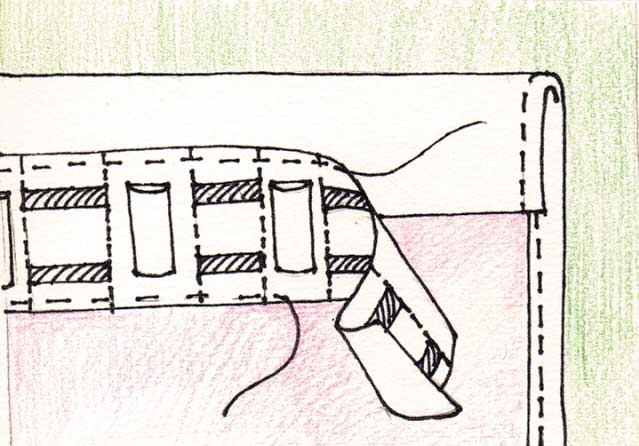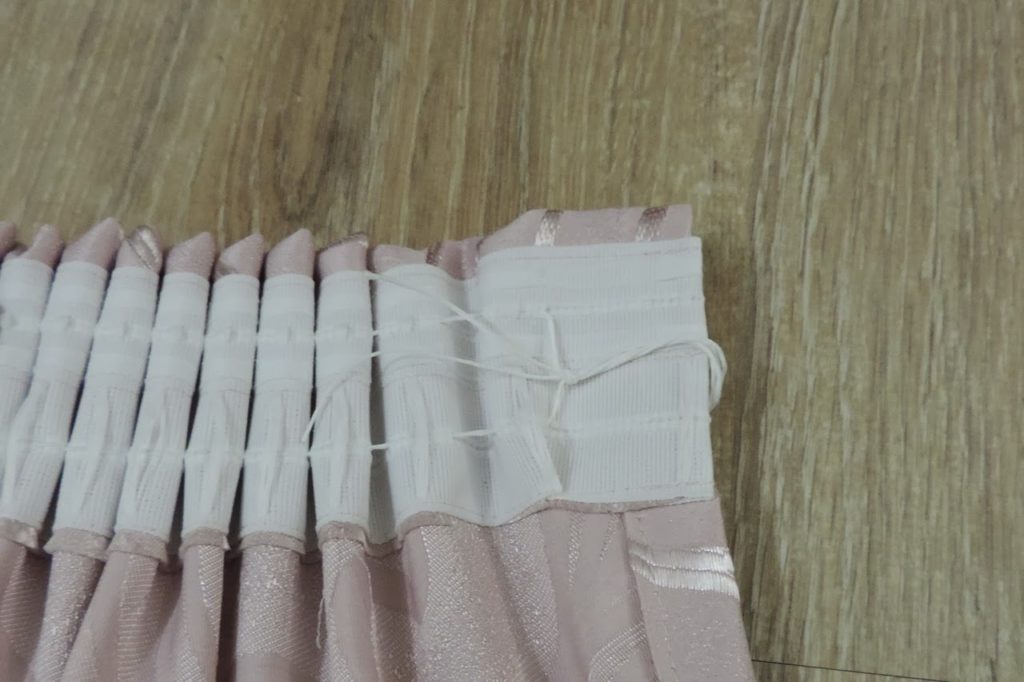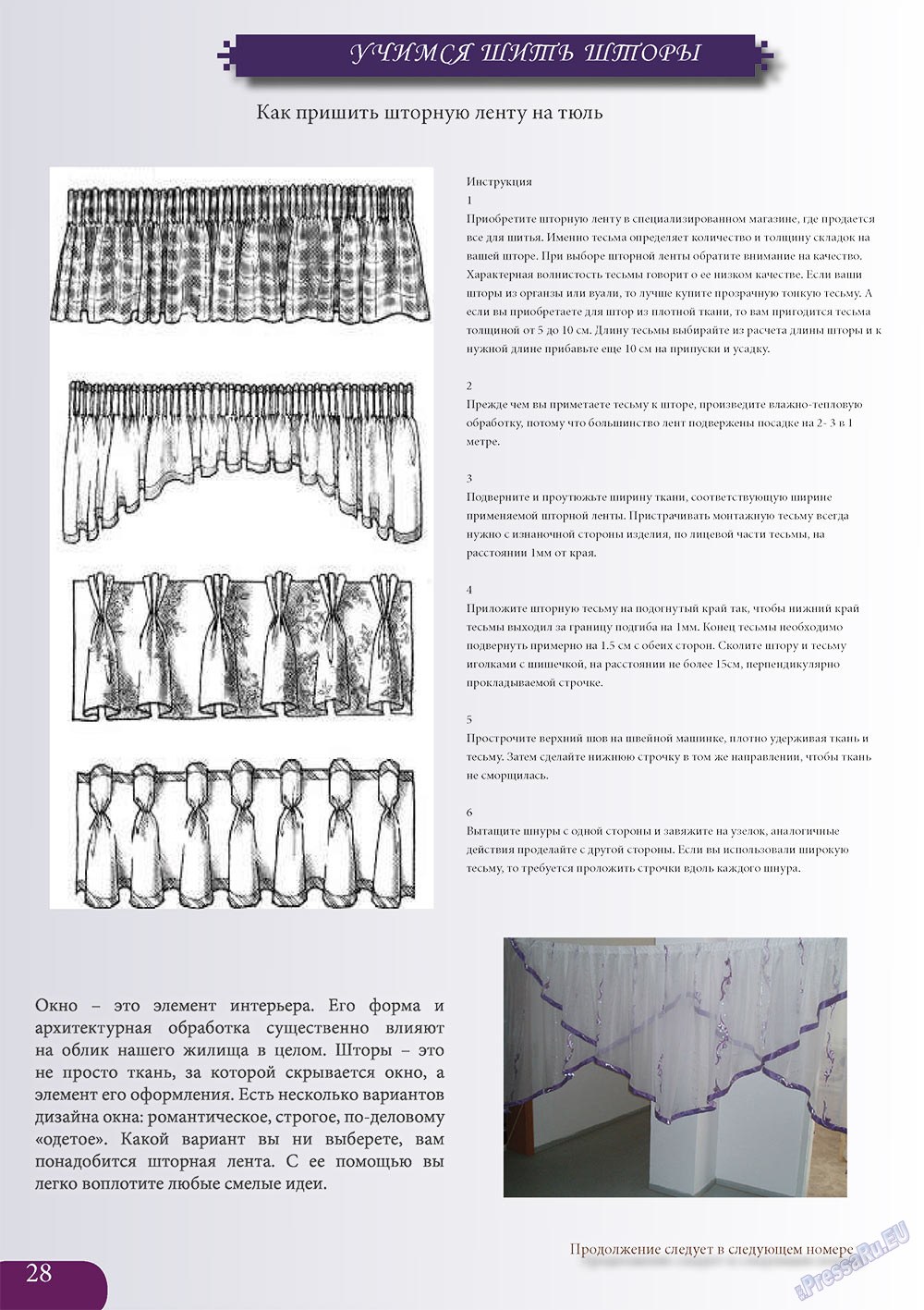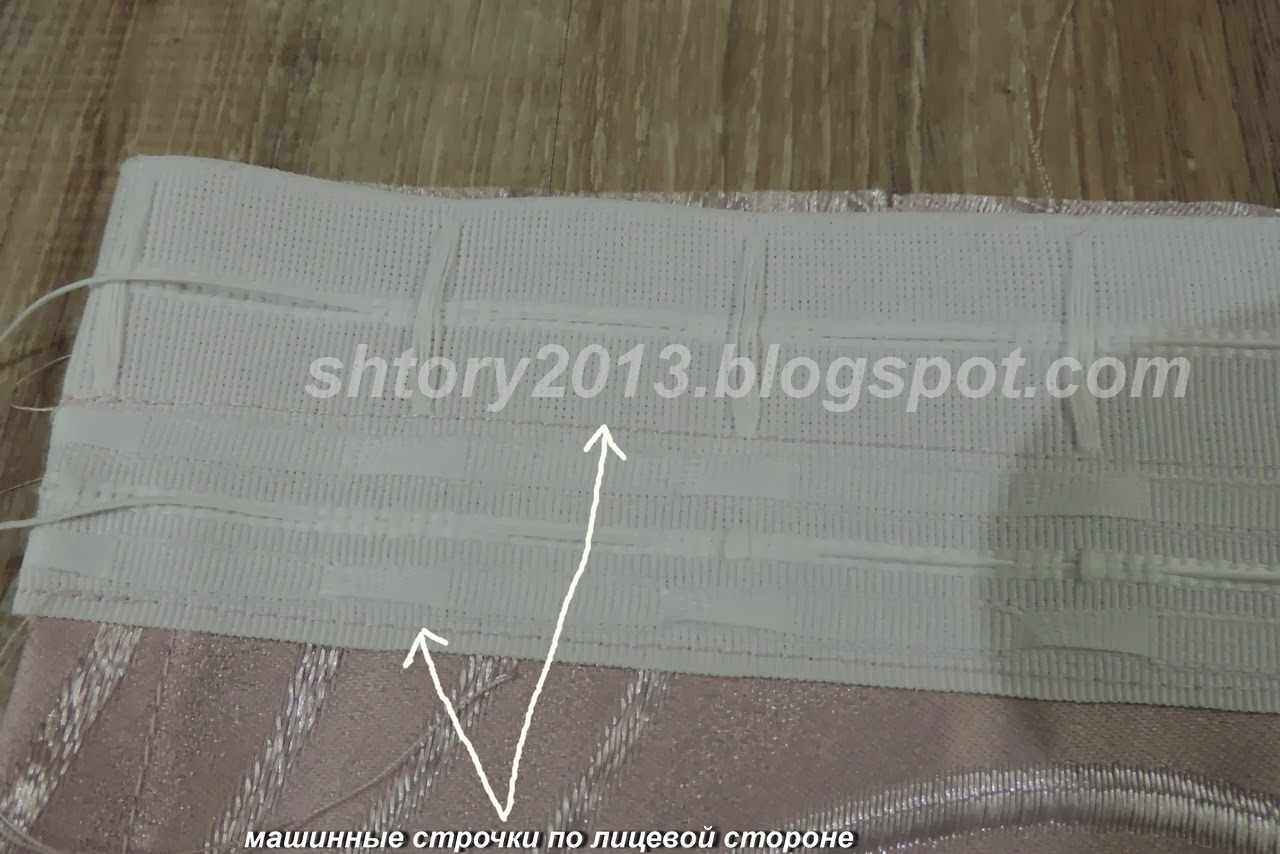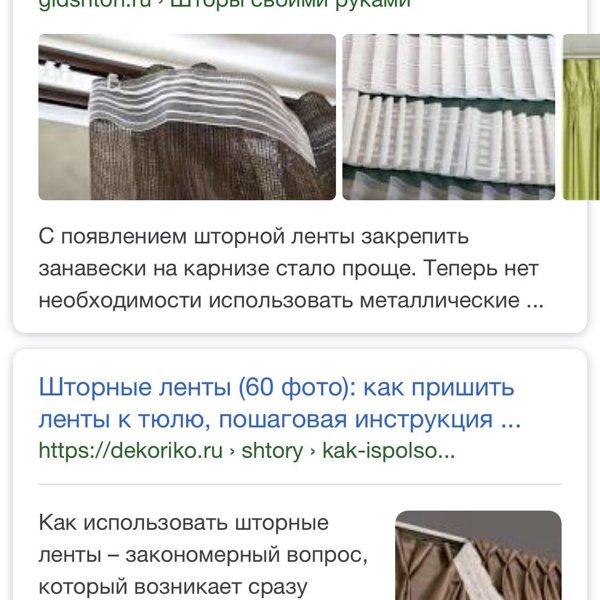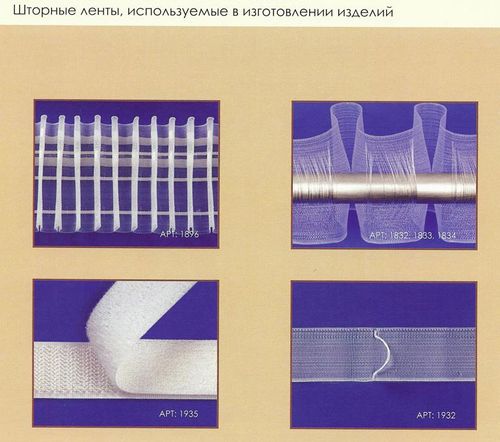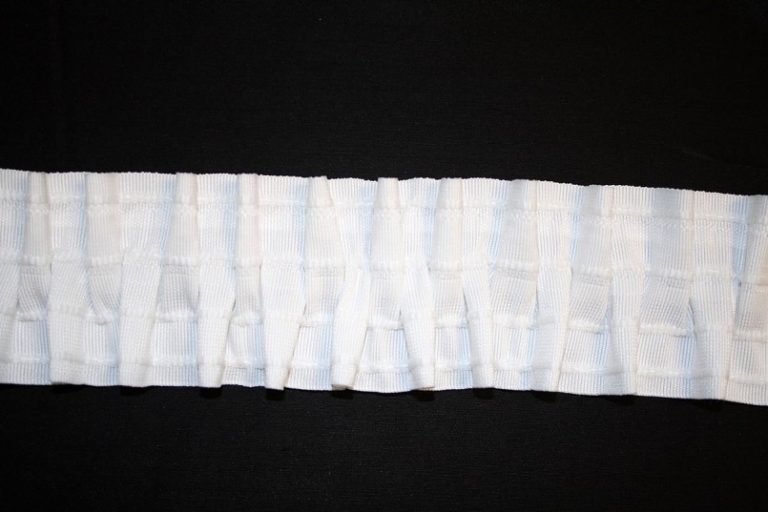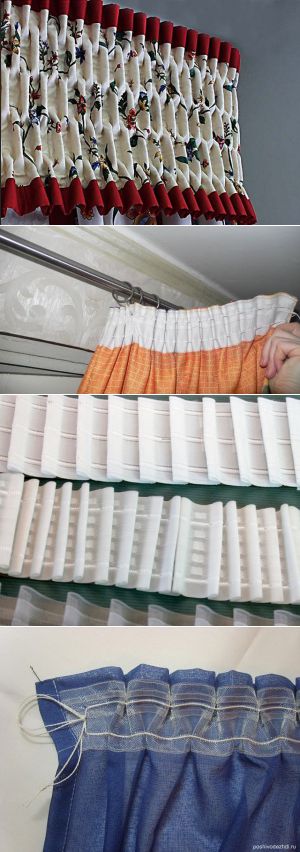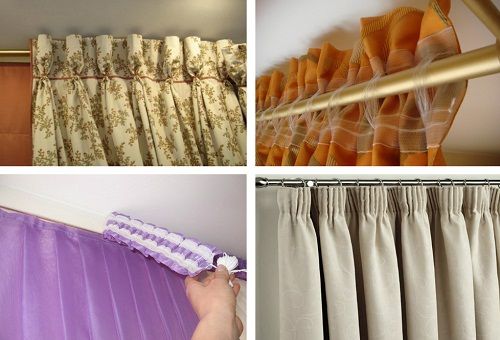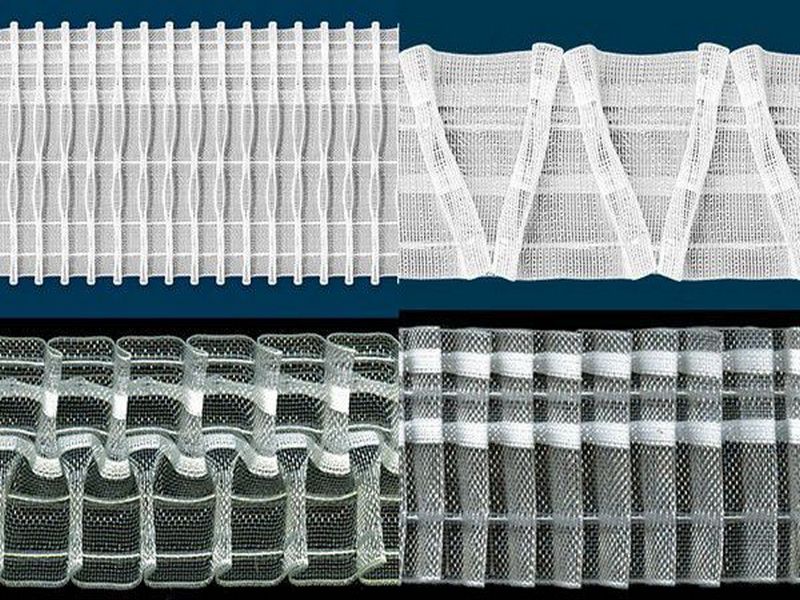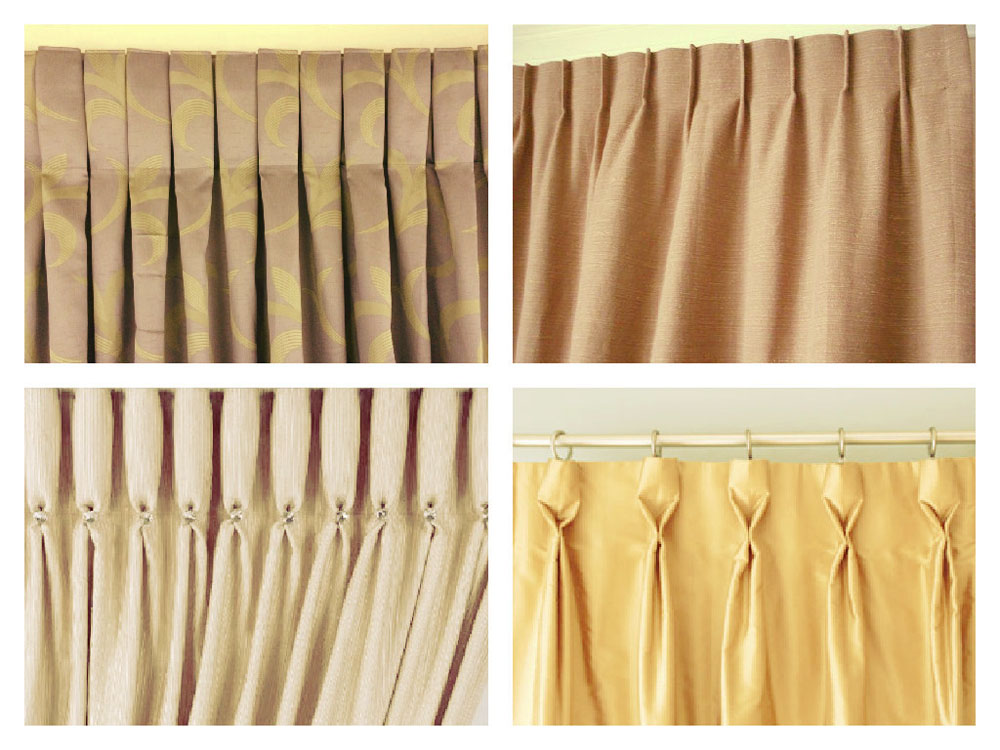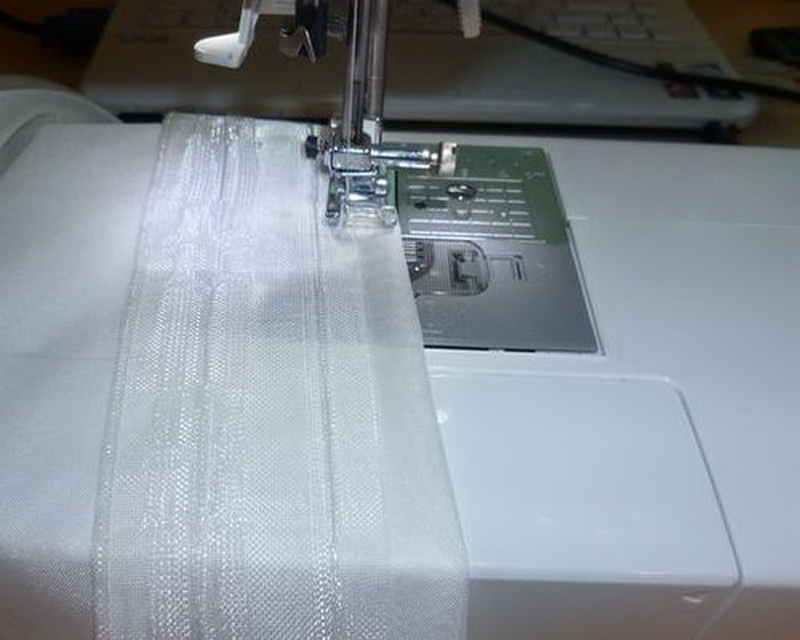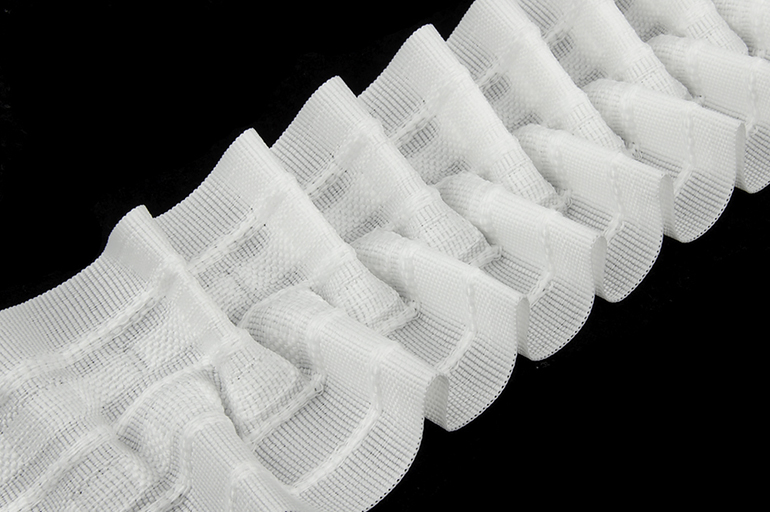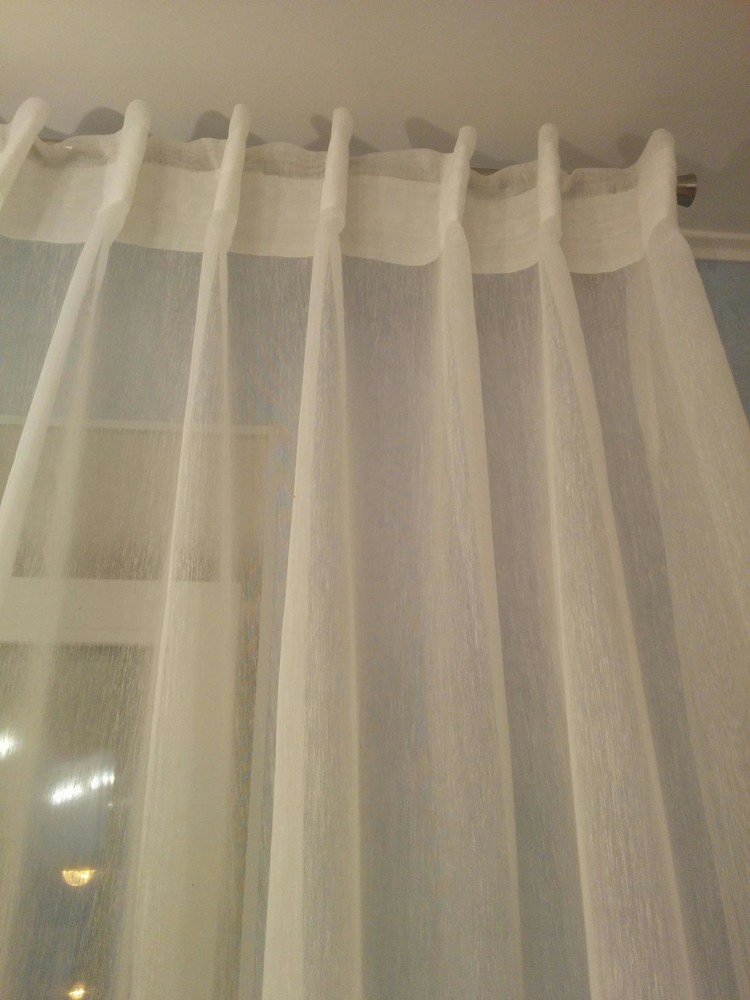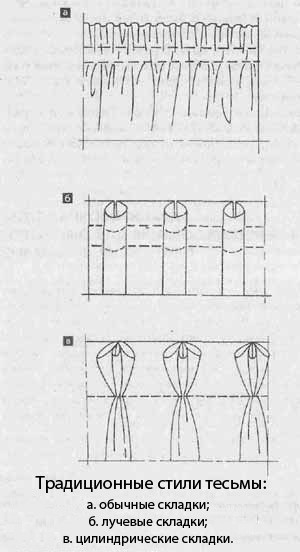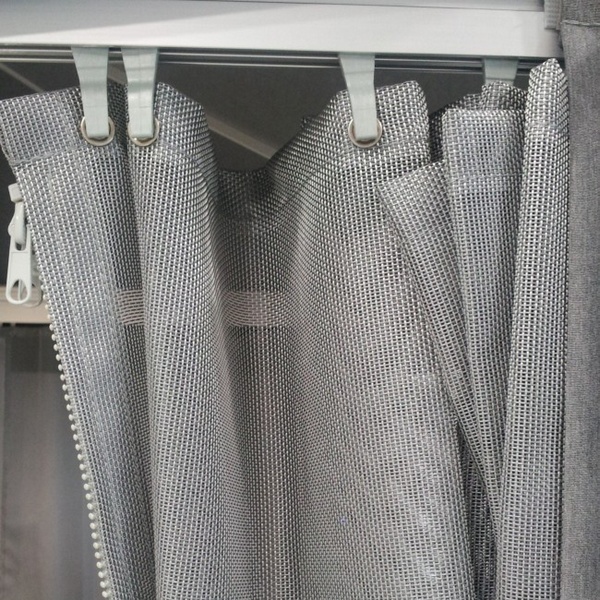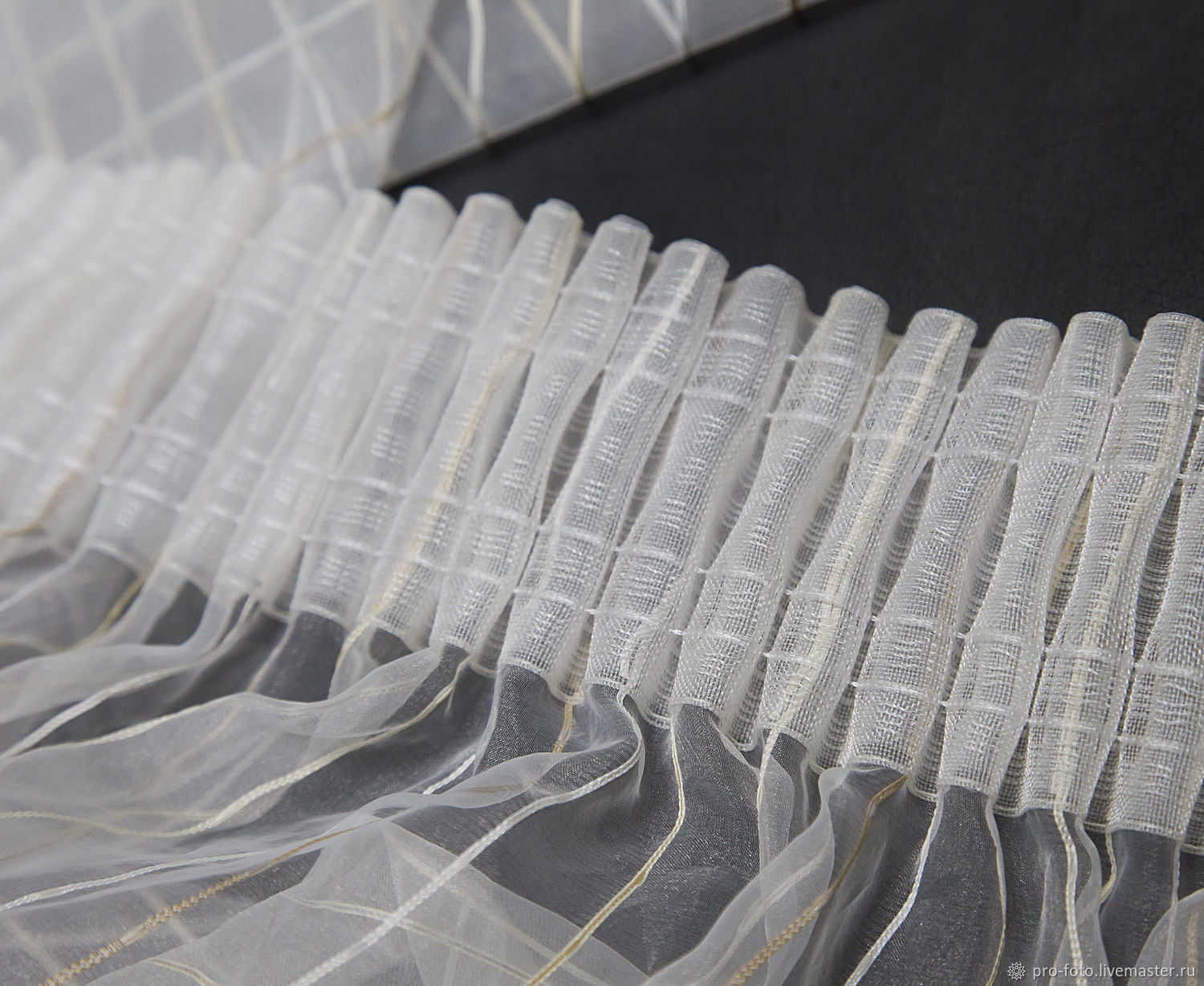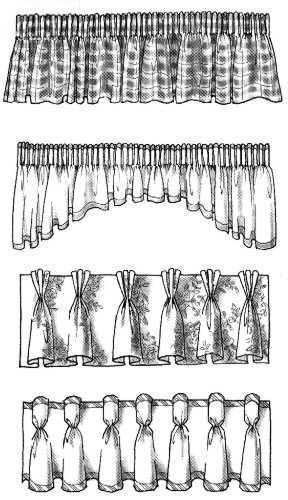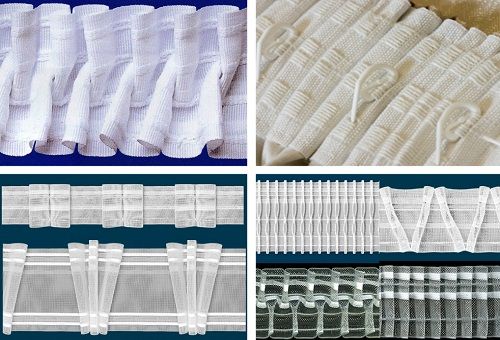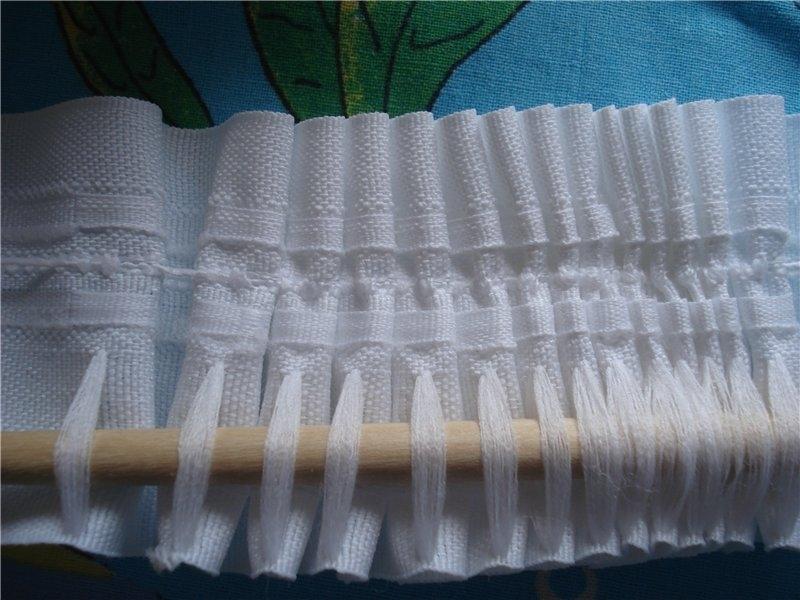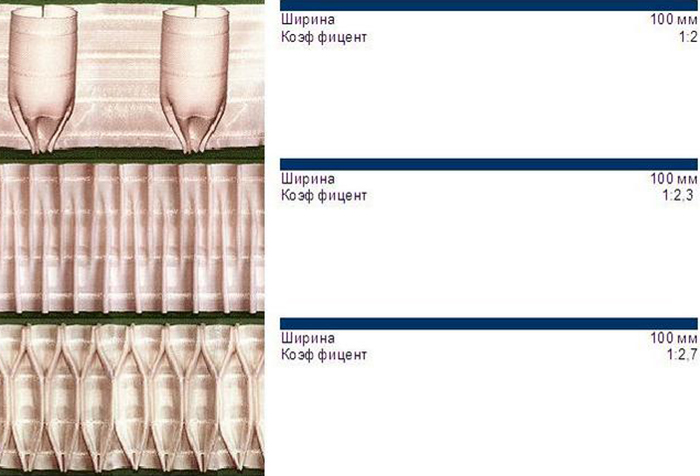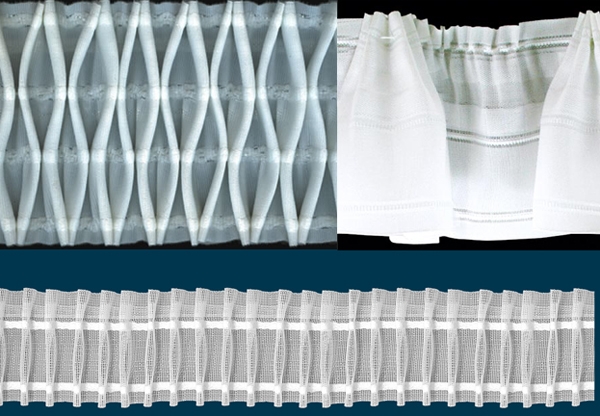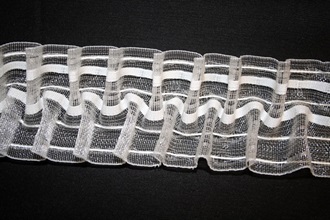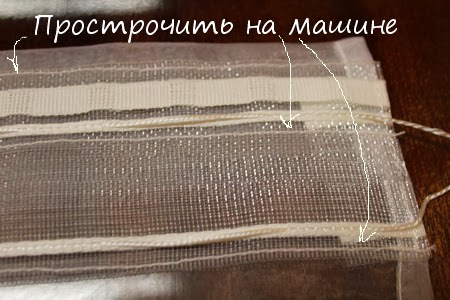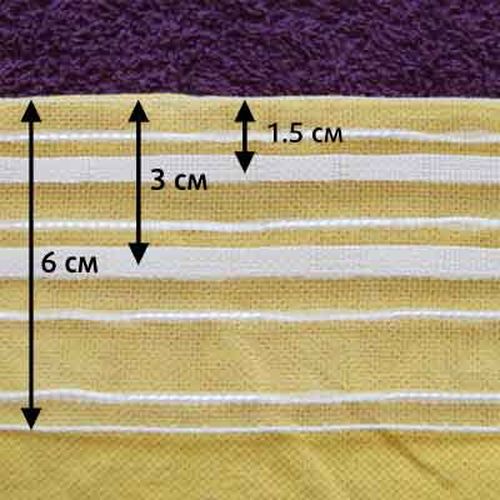Curtain tape for curtains and tulle
Curtain tape resembles a ribbon and is white or colorless. Parallel ropes are drawn along its entire length, and in the middle there is a dense layer with loops for hanging curtains from the fixing device.
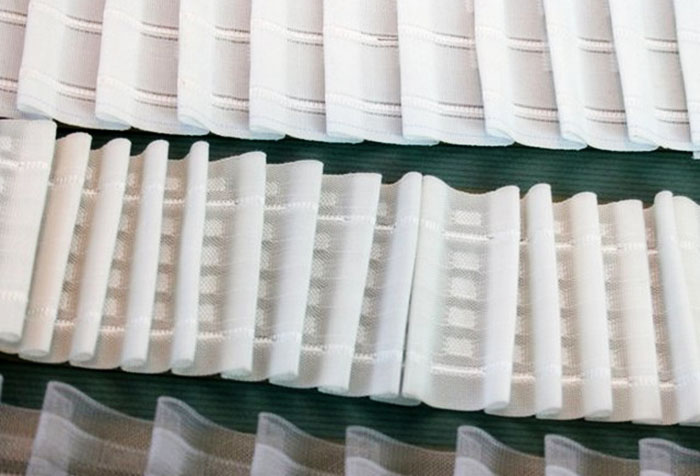
A curtain tape is a fabric strip of different widths, along the entire length of which thin strings or laces are stretched in one or several parallel rows.

The material for the curtain tape can be both natural and synthetic fabrics of different densities.
Curtain tape is a special type of soft decorative fittings used to form folds of various sizes and shapes. This is a kind of skeleton for all variations of assemblies. With the advent of tape, fixing the curtains has become much easier and more convenient. It is no longer necessary to attach metal clips that damage the base or sew on eyelets by hand. In total, there are about 70 varieties of braid.

In the middle of the tape there is a denser layer with loops designed to hang curtains from the baguette, and the strings are used to create assemblies of the desired shape and size.
They differ in the following characteristics.
- Fixation methods. These can be eyelets, eyelets for hooks, strings, pipes, as well as sticky stickers.
- Fold configuration. There can be many options, which depend on the wishes of the customer or the imagination of the author.
- Dimensions. Braid from 1.5 to 10 cm is considered standardized. 2.5 and 6 cm are more in demand.
- Material. For upholstery of airy organza and veils, they use fishing line, and for thicker weighty textures, polyester, cotton and paper.
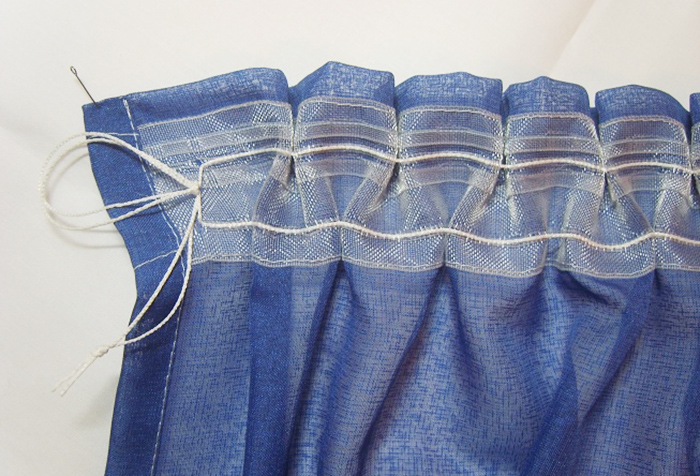
After pulling the laces, folds form on the surface of the curtain, they can be given the desired shape.
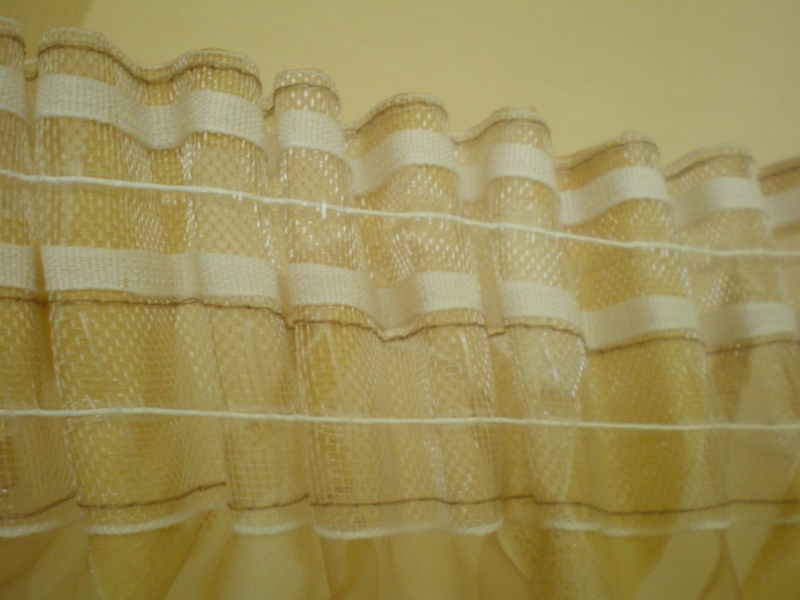
To remove the curtains, you just need to untie the laces and straighten the ribbon.
IMPORTANT! Curtain tape is sewn from both natural and artificial fabrics of various densities. The braid, made of tough materials, perfectly holds its shape
Step-by-step instructions for using curtain tape on hooks
To decorate a room, it is important to know how to hang curtains on a ribbon on a bar for a more durable "fit". The product can already be sewn on in an industrial way, or it can be attached independently
In order for the finished composition to hold firmly, it is important to know the order of its design and choose the right braid, taking into account such an indicator as the assembly factor.
KS determines the "pitch" of the fasteners, depending on the width, which is important for the number of assemblies and their splendor.
When hanging curtains, it is important to properly sew on the hook tape. This operation is performed as follows:
- a piece is cut from the strip equal to the length of the curtain with an increase of five centimeters;
- lay the ends of the braid down by 2.5 cm each and smooth;
- pull out the cords so that they hang freely and are not secured;
- put the tape on top of the upper trim allowance and chop off;
- sew 12 mm at the top and bottom, sew twice.
If the curtain tape has several strings, we sew it along each of them.
Important! Stitching is necessary to close the fold so that the cords remain free. Then, stepping back from the side edge 10cm, you need to hang a hook - it will be the extreme
Having turned the curtain on this hook, the next one is hung on two loops at once - the extreme one and the one opposite to it. This action is called a technical turnaround. It can be done in another way: tuck in immediately when the strip is sewn
Then, stepping back from the side edge 10cm, you need to hang the hook - it will be the extreme one.Having turned the curtain on this hook, the next one is hung on two loops at once - the extreme one and the one opposite to it. This action is called a technical turnaround. It can be done in another way: tuck in immediately when the strip is sewn.
The pleats obtained on the braid after tightening the ropes should be evenly smoothed.
The next element is threaded into the loop close to the fold, it is also threaded into the second - after five centimeters. The result should be a crease. Further, the formation of the drapery using the curtain tape on the hooks is done in the same way.
Curtain tape is a handy fixture used on any curtain, curtain or curtain.
How to choose the width of the curtain and the length of the curtain tape
In the process of determining the width of the finished curtain, it is necessary to take into account 2 points: the length of the cornice, as well as the so-called assembly factor. The latter depends on the type of folds. So, for example, if you plan to make a simple even drapery, the coefficient will be 2.0, and if curly folds - 2.5. This indicates that in the first case, to determine the width of the finished curtain, the length of the cornice must be multiplied by 2.0, and in the other, by 2.5.
It is much easier to calculate the length of the braid. Since it is fastened along the upper cut, the length of the fabric strip should correspond to the width of the curtain without folds + 8 cm per hem.
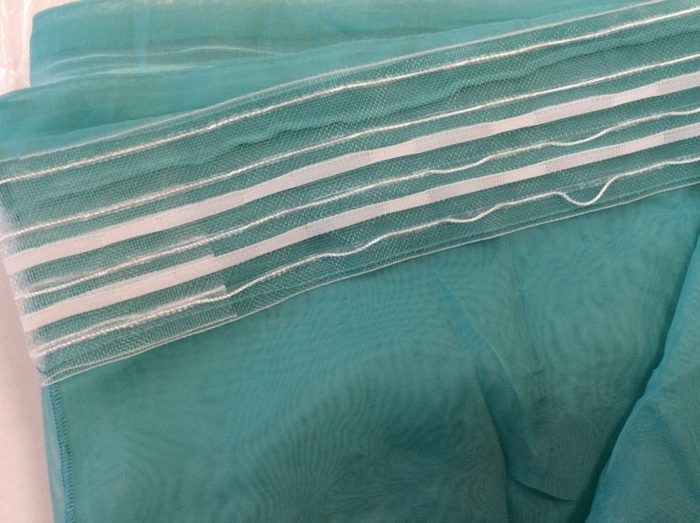
The size of the tape is easy to determine
Secrets of choosing the right curtain tape for tulle
To get the expected result with minimal effort, you need to choose the right accessory. It is enough to know a few simple conditions:
- The tape can be fixed on the canvas not only by machine stitching; curtain tapes on an adhesive base, which are fixed during heat treatment, are also widely known. They are precisely intended for thin gaseous material. This braid will perfectly hold tulle and its like.
- Depending on the shape created by the curtain composition, a tape with loops, a seal or pockets for hooks is used.
- The width and transparency of the canvas play an important role when choosing a curtain tape. For tulle, a narrow, porous, almost invisible braid is most suitable.
- It is also necessary to take into account the number of cords piercing the tape and the required drapery intensity. This must be correctly compared with the size and quality of the matter so that the resulting folds look harmonious.
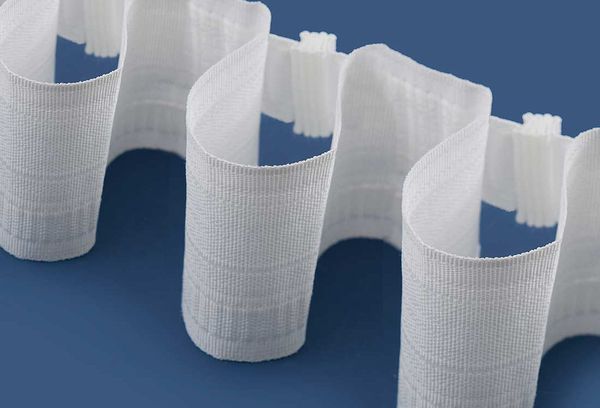
Methods for attaching the weighting agent
If you wish, you can sew the curtains yourself with additional weights. The cargo is prepared in advance, fabric to match the color of the curtains, a sewing machine, threads, scissors. Measurements are taken with a centimeter tape or tape measure. The method of attaching coins or wire depends on the weight of the web.
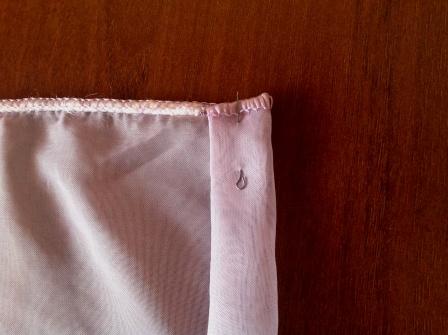
Tulle and lightweight materials - use weights weighing 12-22 grams.
The sequence of internal attachment of the weighting material to a light canvas:
- If the curtain is lightweight, then it is recommended to sew the strips on the sides. It is enough to take 2 parts weighing no more than 22 grams.
- Each item must fit into a fabric pocket that is sewn separately.
- On the back side of the lower fold of the curtain, a small incision should be made, observing an interval from the bottom of 5 cm. If the material is not tucked, then it is allowed to use curtain tape.
- A pocket with a weighting agent is inserted into the resulting incision and sewn to the curtain.

To insert the details, preliminary preparation of the bottom edge or side of the curtain is required.
When the curtain is made of dense, heavy material, the load must be sewn in in a different way. On the reverse side, in the lower part, several pockets are made into which coins or metal balls are inserted. The folded bottom of the curtain can serve as a place for the location of the parts.
A curtain tape is sewn to close the holes
It is important to fix the weights so that they do not fall out when the curtain is in an inverted position.To fix the wire or chain, you first need to make a 10 cm hem of the fabric and sew it
A weighting agent is threaded into the resulting hole.
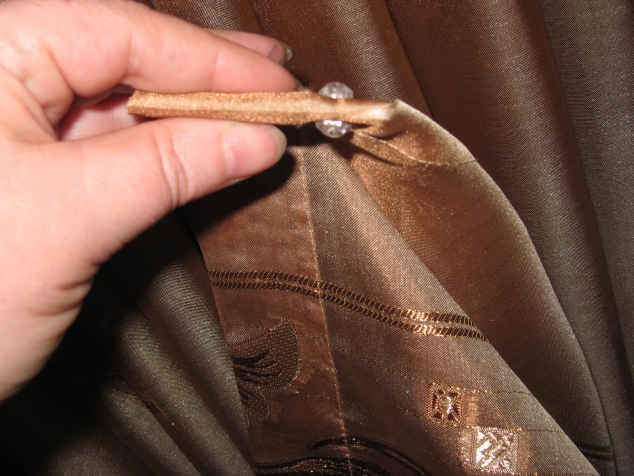
To prevent the load from shifting, the side edges of the fold are sewn up.
It is not necessary to sew a special pocket to fix the curtains in one position. Frequently, loads are attached outside the curtains. In this case, curtain weights or products with holes are used. Old coins will come in handy from scrap materials. The bottom of massive curtains is decorated with fringes or pendants, but such a detail is appropriate in classic or retro interiors.
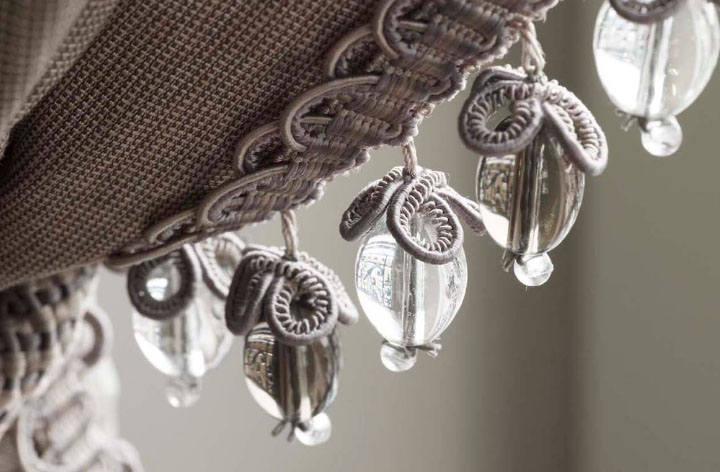
Another option for weighting in the form of a special fringe attached to the bottom of the canvas is suitable for massive heavy curtains.
Organza curtain weights do not need to be placed in a special pocket. Here, a special cord is used to match the curtains, and is sewn on the back of the canvas. It is forbidden to use chains and slats for organza curtains.
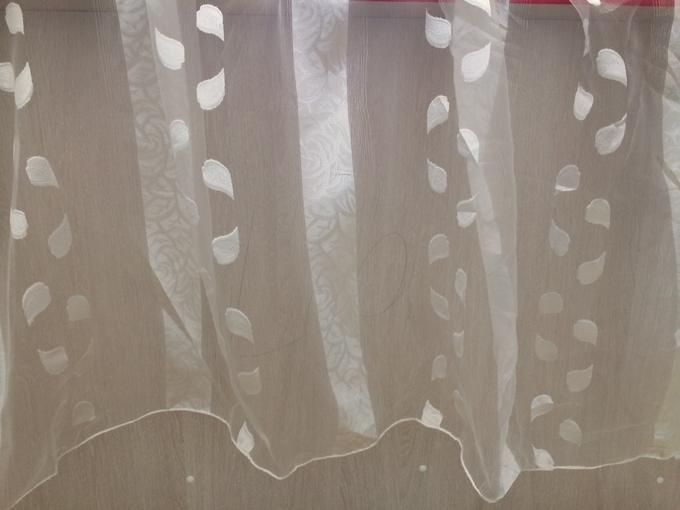
To sew the weight on the organza, the material selected for balancing is sewn directly to the bottom edge without forming a pocket.
Benefits of curtain tape
This is a strip made of different materials. For curtains made of thin fabrics: organza, veils and others, a transparent soft thin but durable material is used. To work with denser bases, the thickness and texture of the braid will be different. It is easy to sew it on a typewriter in any part of the product, depending on the design ideas for the execution of curtains.
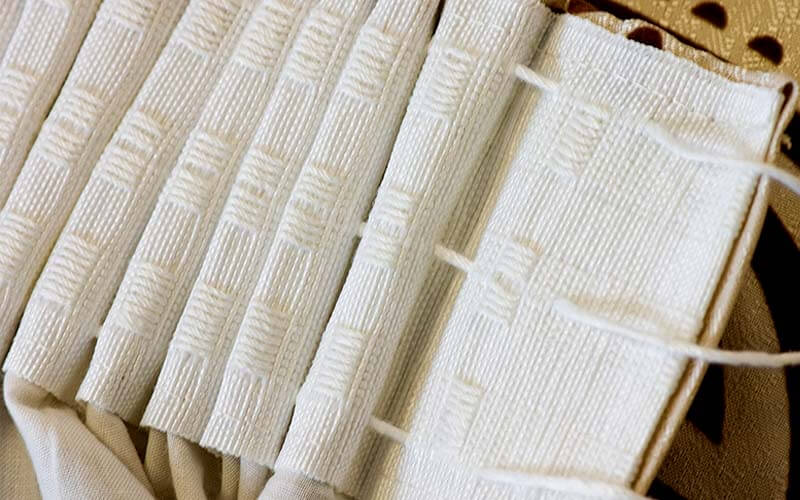
A very convenient device for draping curtains is a curtain tape.
With its help, you can form folds of various configurations by adjusting their size and number. It has the following features:
- facilitates sewing products;
- there is no need to sew on the loops for the hooks - they are already on the tape;
- makes it possible to drape fabrics of any texture and density;
- allows you to design window openings in an original way;
- with its help, you can adjust not only the length, but also the width of the curtains.

With the help of the curtain tape, beautiful folds are created, of the same size and shape.
In addition, after washing, it does not shrink, it retains its shape.
Using the curtain strip, you can carefully process the edge, attach the finished curtain to the curtain rod without using special clothespins.
Products are presented in a variety of options and differ in fastening methods, size, shape of folds, which can be decorated by fantasizing.
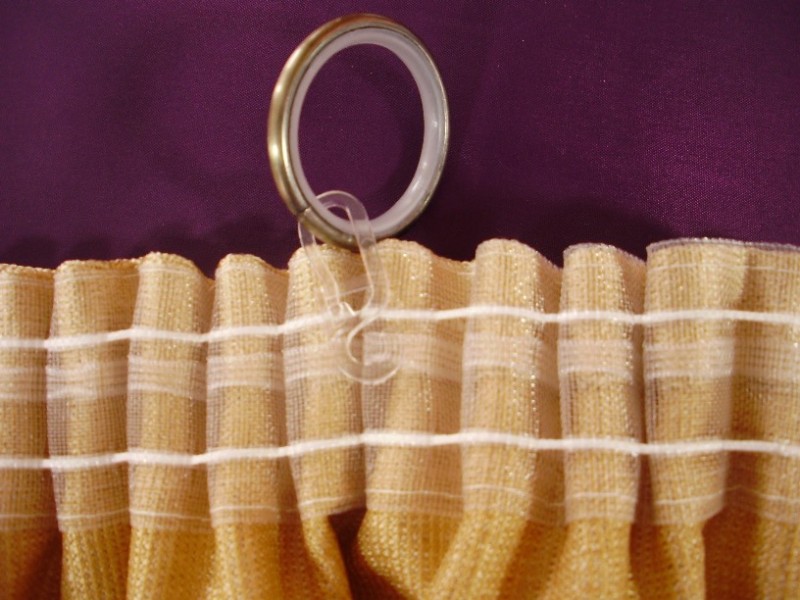
They are made from fishing line, polyester, non-woven base.
The connection methods are also different, one of which is the fastening loops for the hooks.
They are placed not only in one, but in several rows. The features of the drapery design depend on this:
- simple folds are formed on a strip with two rows of loops;
- the upper part of the curtain can be decorated with a strip with a four-row installation of fasteners.
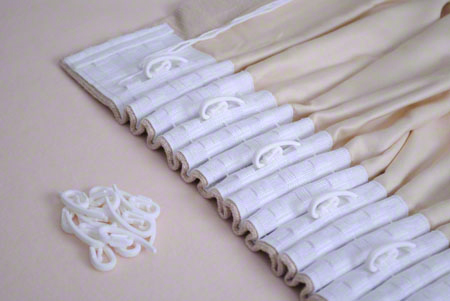
You can attach the strip to the curtain by sewing it on or gluing it.
In this case, the adhesive tape is produced in one-sided and double-sided versions. In this case, it is attached to the curtain fabric after smoothing the base with an iron.
Different widths of the tape - from 1.5 cm to 10 cm - allow you to use it for various options for fastening and curtains of different lengths and materials, as well as diversify the methods of decoration.
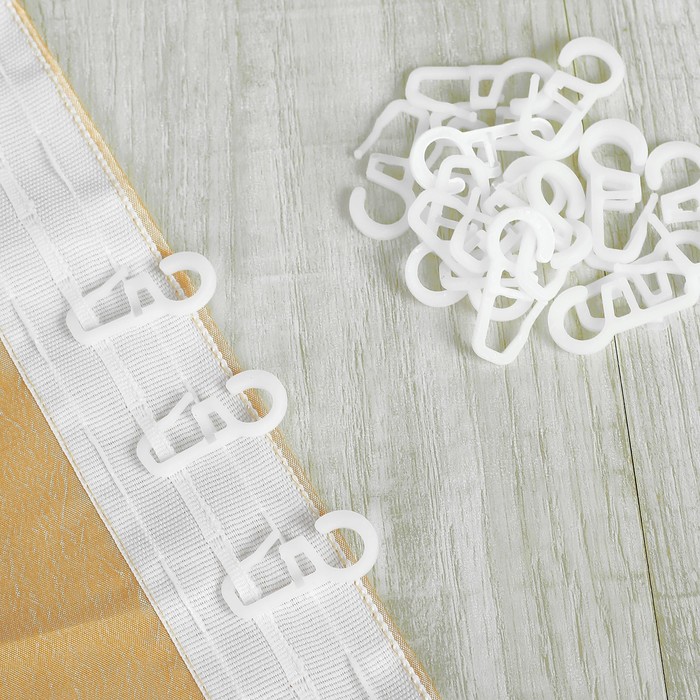
The narrower the ribbon, the lighter the fabric should be.
It helps to perform all sorts of assemblies, including:
- horizontal;
- vertical;
- "Accordion" and other options for drapery, such as "pencil", "glass", "butterfly", "puff", "tulip", fan-shaped and others, where curtain tape is used everywhere for installation on hooks.
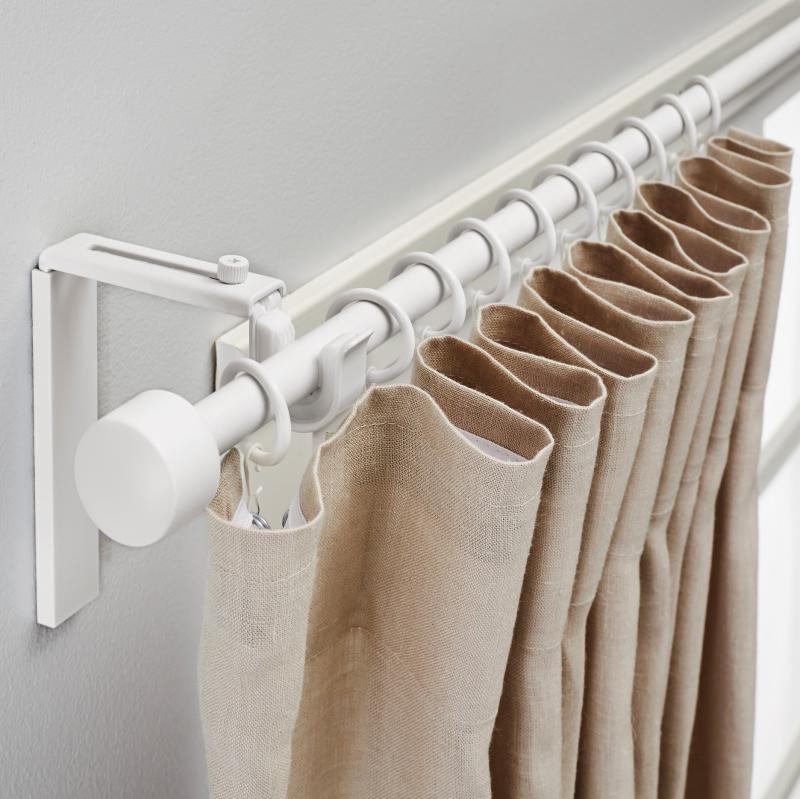
There are several types of curtain tapes on sale, each of which is designed to assemble the canvas in the desired way.
There are other types: zigzag, tubules, triplets. Each type of curtain tape is made from different materials and has a parameter called the assembly factor (KC).It is the ratio of the original width of the curtain to the folded width, and is usually 1.5; 2; 2.5 and 3. (KS) is usually indicated on the product packaging.

The wide band has several rows of hooks that allow you to hang the curtain higher than usual, raising the fabric above the cornice.
How to properly prepare the material
So that you can beautifully sew the ribbon to the curtain or tulle, and the result of the work does not disappoint you, you need to familiarize yourself with some of the subtleties of the process. When folding the tape, leave 3 cm on each side. Since this braid shrinks, it is measured with a margin, and then carefully steamed. The same is done with the fabric to which the fittings will be sewn. In this case, you can no longer expect negative consequences from shrinkage. Sewing on the tape must be free, you can not pull on either the threads or the material.
When choosing a tape, you need to carefully examine the product, and if you see its large waviness, then you can already conclude that the quality of this material is low. Such fittings will not last long and will quickly deteriorate.
How is the curtain tape sewn on?
How to sew the ribbon to the curtain correctly? It's not difficult at all. You will need a sewing machine, thread, needle, scissors and an iron.
- The required length of the braid is measured, leaving an allowance for the sealing of 4-5 cm.
- The upper edge of the curtain is tucked up 2-3 cm and ironed with an iron. If the fabric peels off heavily, it is advisable to overcast the edge with an overlock seam.
- Apply the tape with the seamy side to the seamy side of the curtain on the tucked edge, retreating from the top 0.5-1.5 cm, depending on the type of assembly. The minimum indent is made for simple assembly or for a narrow tape without assembly. Make sure that the hinges (pockets) are outside.
- The end of the curtain tape is tucked up 2–2.5 cm. The ends of the cord are pulled out so as not to accidentally sew them to the curtain.
- Sweep away with large stitches.
- Two lines are laid in the edge: first the top, then the bottom. The number of lines depends on the number of cord lines. The braid is stitched along each cord or guided by the width of the braid: up to 5 cm - two lines, 5-10 cm - three lines, more than 10 cm - four lines. The length of the stitch pitch is 4-5 cm.
- The ends of the cords are tied up, otherwise they may pop out of the tape. Pulling evenly on all the cords of one side, collect the web. Straighten the folds.
The curtain is ready to be hung on the cornice. The cords are tied once more. Do not cut any excess - you will need this length when you are thinking of washing and ironing the product. To prevent the ends from dangling, you can wind them around a strip of paper and hide them under the tape.
When buying a braid for a curtain, they take into account the type of cornice and the method of attaching the canvas to it, think over a design solution for curtains and curtains. To make sure your fabric looks beautiful on the ribbon of your choice, drape a small section of the curtain by hand.
Characteristics and purpose of using weighting agents
Even heavy curtains are not stable and easily move under the breeze. To fix the curtains in one place, special weights are provided. Such devices have different weight, thickness, modification.

A special weighting device provides the much-desired straightness of the lines.
Important! When choosing a weighting agent, it is necessary to build on the density of the web. The higher it is, the more the mass of the element used should be.
Which curtain models need additional load.
- Roman. Curtains have a mechanism by which the fabric is lifted and rolled up in a roll on the cornice. The structure is additionally equipped with a wooden or plastic rail.
- Japanese. These are fabric canvases that are weighted with metal, wood or plastic slats. They are fixed with glue.
- The curtains in the bathroom. Small magnets or plastic parts are used as weights to prevent deformation of the waterproof canvas.
- Tulle.Lightweight sheer fabric can only be finished with lace.
- Heavy curtains. It is recommended to use metal balls and cylinders here.

You can make a weighting agent from improvised items (tape, cord, metal parts, slats are suitable).

In each case, the choice of weighting agent is determined by the properties of the fabric.
The weighting agent allows you to maintain the required shape of the curtains, prevents deformation of the curtains. In addition, such a detail contributes to the rapid straightening of the curtains. Thanks to the small weight, the tulle will always look neat.

Cord and ribbon are used if the main material of the curtains is tulle, organza or other lightweight fabrics.
Length calculation
When choosing a curtain tape, you need to collect part of it by pulling the ends of the cord. If it keeps the shape of the folds well, then it is worth using it for further work, and if the assemblies are uneven, then it is better to look for another option.
The curtain tape must be sewn with a full-width curtain, it can significantly exceed the length of the curtain rod or curtain, due to the creation of decorative folds. In order to correctly calculate the required width of the material, a special coefficient is used:
- 1.5 is used to create a simple assembly on curtains or tulle;
- 2.0 is used for more complex ones, the formation of ruffles, waffles;
- 2.5 allows you to create ray and bow folds;
- 3.0 is required for the most complex, triple or cylindrical folds.
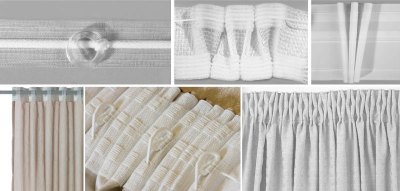
The length of the braid and the width of the curtain must be correctly calculated based on the size of the fastener multiplied by the factor necessary to create the necessary assemblies.
That is, for a curtain of 3 meters with the formation of cylindrical folds, 9 m of canvas and the same amount of braid will be required. If the length of the curtain is insufficient, assemblies will have to be done much less often, as a result, the expected effect will not be obtained.
How to sew braid
Before starting work, you need to prepare the necessary tools and accessories. You will need thread, scissors, chalk, a tape measure, pins and, of course, a sewing machine.
Everything is ready - you can get to work. The author of the site "GidShtor" has figured out how to properly sew the curtain tape to the curtain.
- The first step is to cut the edges on the canvas from which the curtain will be made. Usually, the factory edge pulls the material and the curtain wrinkles at the hem on the side, so it is better to cut the edge off. To make an even cut, it is necessary to pull out the thread along the entire length at a distance of 1.5-2 cm from the side edge and cut the material strictly along the resulting line.
- Next, the side edges are folded. To do this, wrap the material on the seamy side of the canvas twice, laying 2.5-3 cm each. It is better to pin the fold or sweep with large stitches, but experienced craftswomen can do without this. Side seams are sewn and steamed with a hot iron from the face and from the inside.
- Before sewing the braid to the curtain, the top of the fabric must be ironed thoroughly. To avoid shrinkage, the tape should also be steam ironed.
- Apply the tape to the front side of the material so that the upper edge of the canvas is 1 cm below the upper edge of the curtain tape. The side edges of the braid are folded inward.
- Sew the bottom edge of the tape onto the curtain, being careful not to pull the material.
- Flip the fabric inside out and fold the braid over. They are pinned along the entire length with pins and stitched over the very edge of the tape, constantly straightening the fabric to avoid wrinkles.
- If there are two or more cords on the tape, you can sew a seam in the middle of the strip, being careful not to touch the hook loops and the tie cord.
- The tape is tightly sewn to the curtain. Now you need to iron it again and close one side cut with a short stitch. On the other hand, the side edge of the tape is left open. This is a convenient place to hide the ends of the cords after the pleats are complete.
- Pull the braid on one side, distributing the waves of the folds evenly along the entire length.After finishing the drapery, the ends of the cords are tied and tucked on the side under the ribbon.
So, the step-by-step instructions will allow you to sew a curtain tape yourself, even the most inexperienced hostess in sewing business. In order not to be mistaken with the choice of accessories, you can see on a small piece of material how the braid will work and whether the resulting drapery matches the overall design.
How to sew lace to tulle
In this version, a thin ribbon is suitable. The first step is to calculate the parameters of the tulle and braid. This can be easily done by multiplying the length of the curtain rod by the factor of assembly of the fabric with the addition of 25 cm for deformation and processing.

There are also such types of ribbons as a column that forms assemblies 1 to 2, and an Austrian ribbon that forms various patterns and forms folds into "puffs", "butterflies", "glasses".

A tape of 1.5-4 cm is considered narrow. It is necessary when the cornice is covered, when the hooks are covered with a special decorative strip.
When choosing a wide tape, observe the following sequence of actions:
- Finish the tulle carefully on all sides except the top. If the material is loose, then overcast it additionally on the overlock. You can pull back three strands and cut in a straight line.
- Fold the tulle on top with the wrong side to the width of the curtain ribbon and iron it.
- On the finished turn-up, apply the lace for the tulle, stepping back from the bend to 1.5 cm. The more complex the folds, the greater the distance required. Make sure that the tape does not protrude beyond the border of the canvas.
- Secure the ribbon with pins and baste it over the tulle.
- Sew the tape with a typewriter. The number of seams must match or be greater than the number of rows on the tape. To avoid creases, the material should be slightly pulled and sewn always in one direction.
- Finish the side edges and remove the basting.
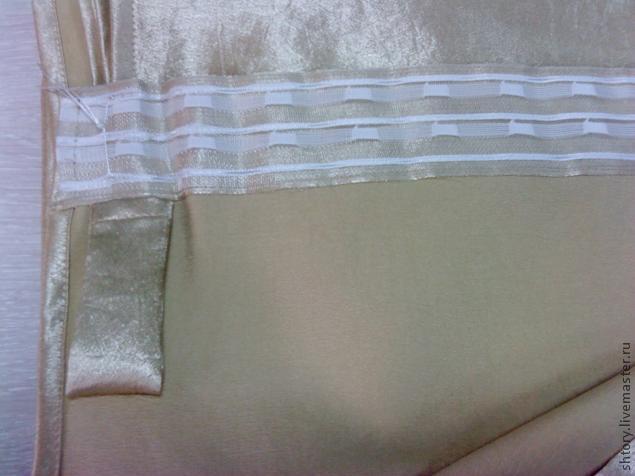
Narrow tape is also used for short curtains made of light fabrics.
If the braid is narrow, the upper cut is folded inside out by 2 cm, and then overcast by hand. In this case, the curtain tape is fixed with pins of 5 mm. from the top edge. Then sew in any convenient way
It is important to remember that the eyelets should be on the outside of the string to secure the hooks or rings.
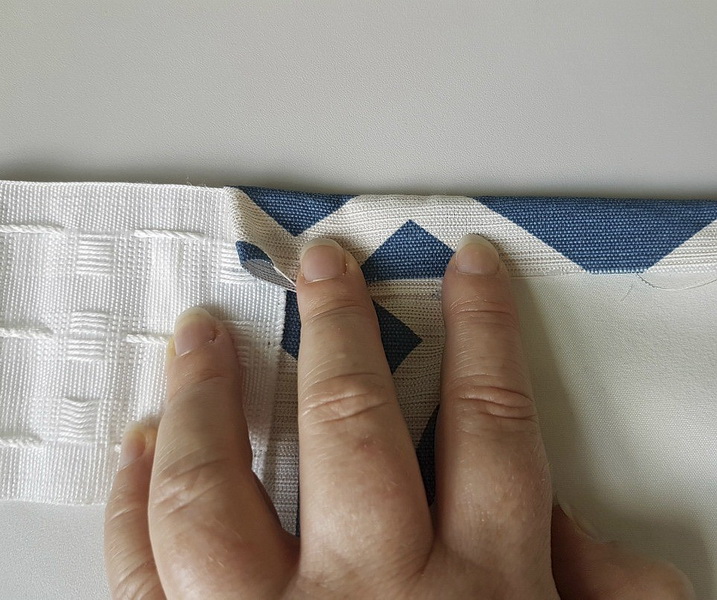
As there are many types of curtain tapes, there are also many options for decorative types of folds.
Note! When working with tulle, it is necessary to avoid unnecessary holes from needles and pins, as the fabric can deform. Tulle is an obedient material, and many novice seamstresses begin to "fill their hand" on it.
Types of draperies
There are a large number of draperies for curtains. Let's consider the main types. The most common types are pencil and column folds. The latter are formed by pulling the tape on the laces. Puffs, butterflies, glasses - types of folds that form voluminous lush structures. Making them is easy. Bow folds (counter) are created with a certain effort, but depending on the material, they can look both strict and romantic.
Waffle and French curtains look spectacular on wide lace. If you want classic pleats with a twist, use diagonal straight draperies.

If you decide to immediately form folds on the curtain, then the amount of curtain tape you need for work will increase, and its consumption will be greater. Add another 15-20 centimeters to the calculated amount, because the edges of the tape will need to be bent, processed.
Ready-made curtains on a tape: examples, description.
Curtains, decorated on a ribbon for curtains, will add originality to any room, if they are selected tastefully, harmoniously fit into the interior.
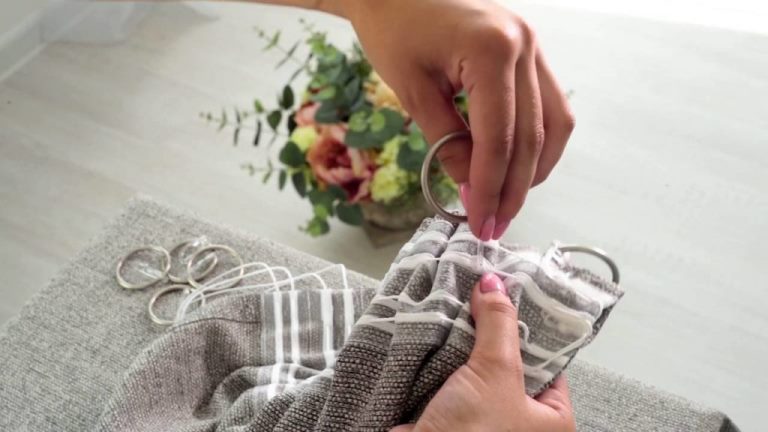
It is better to place the hooks at a distance of 5-6 centimeters, so you protect yourself from the sagging of the canvas.
Moreover, they can be used when decorating rooms in a variety of colors and any style:
- For minimalism and hi-tech, a laconic performance is suitable, without any "embellishments";
- Provence and shabby chic will delight you with light weightless curtains with soft floral or checkered striped patterns, beads, beads or ribbons along their bottom;
- The children's room will be filled with a special spirit of childhood and mischief, if clamps in the form of funny animals, butterflies, flowers, cars or bows are used to fix curtains made of fabric that does not shrink during washing and does not fade.
To decorate and add originality, a variety of elements can be used, sometimes unexpected ones, such as brooches, soft toys, bracelet rings, large buttons.
The classic style, as well as baroque or rococo, is characterized by the wide use of cords and tassels.
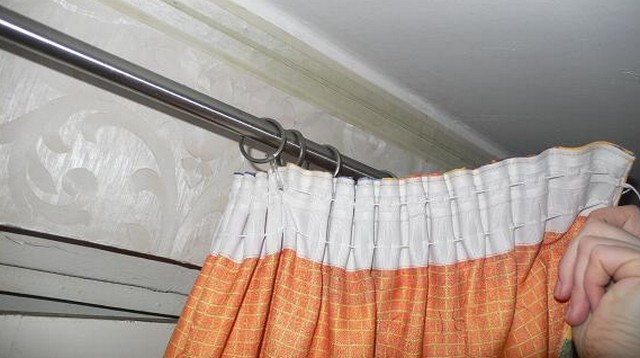
Taking into account the style features of the interior allows you to achieve the best result when draping, to give the room originality and uniqueness.
Examples of room decoration with curtains with a detailed description of the procedure can be found on the Internet.
How to hang tulle on a curtain tape correctly and beautifully
If a very thin and delicate fabric was purchased for the curtain, when decorating it, it is important to know how to hang the tulle on hooks, and to be extremely neat and attentive, avoiding unnecessary punctures in the canvas so as not to deform it
The braid sewn to the curtain allows you to decorate the window opening in an original way, to drape the curtain with soft waves.
It should be noted right away that to work with such thin materials, you will need a transparent or translucent braid. It is available in various widths. Which one is suitable for decoration - the craftswoman decides.
Curtain tape is a simple, quick way to hang light tulle, drapes or heavy curtains.
Before hanging the tulle curtains, you will need:
- measure and carefully trim the canvas,
- cut off excess;
- process the edges and places of the cuts.
After that, you can sew on the ribbon in the following order:
- bend the top edge along the width of the strip;
- iron the edge of the fold carefully;
- tuck inward along the edges and attach to the edge of the ironed fold line, which will prolong its service.
As a rule, narrow (2.5-4 cm) braids are used on curtains where drapery is not needed.
Additional Information. Before starting work, it is necessary to wash the fabric so as not to spoil the finished curtain if it suddenly happens that the fabric shrinks after washing.
How to sew a curtain tape to a curtain: step by step instructions
In order to accurately attach the braid and hang the curtains, you need to know how to attach them to the cornice. The wrong choice of the canopy method can harm the author's idea and spoil the design concept. In addition, this is often the cause of the collapse of the entire mechanism. In construction hypermarkets, you can see a variety of samples of cornices. However, the most popular are metal and wood products, as well as ceiling and string models.
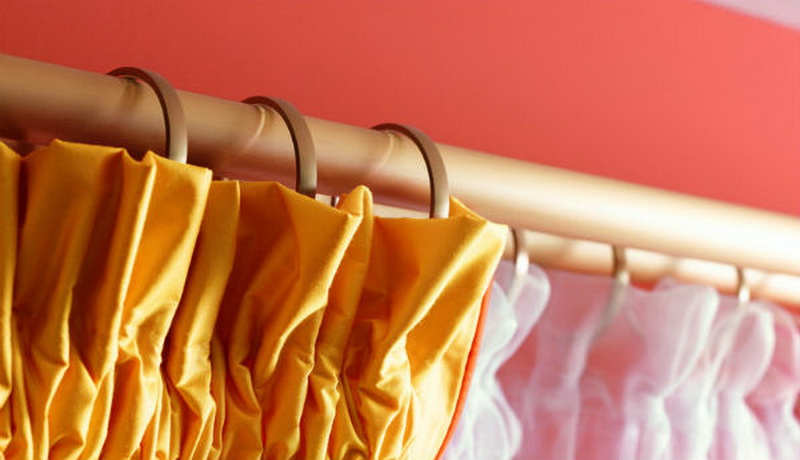
The curtain tape makes it much easier to decorate the window, especially since you can easily sew it on yourself.
The methods of attaching the curtains to them are as follows:
- Rings. The most budgetary and common fastening method. In addition, they are often included in the basic set.
- Drawstrings or pockets located along the top line of the curtain. Designed for fastenings with a circular cut.
- Clothespins. Suitable only for weightless materials.
- Clips. They are similar to clothespins, but lack teeth. Designed for lightweight textiles. Some subspecies are equipped with locks and may have a design treatment.
- Textile loops are made from the same fabric as or similar to the main product.

Ribbons made of hard fabrics hold their shape very well.
Next, using a photo and step-by-step instructions, we will consider how to sew a tape to a curtain. This master class will be useful for both beginners and more experienced craftsmen.
How to hem tulle - tips for beginners
If you have a sewing machine at home, then you can handle tulle hemming easily, quickly and easily.First you need to make the necessary measurements and, if possible, cut off the excess length.

If you do not want to trim the fabric, then make some hem and sweep by hand or using a typewriter.
Sew long stitches and use pins or needles as needed. After the basting, iron the hem well with an iron, this will help to make the fold line as even as possible. Next, you should sew on a sewing machine.
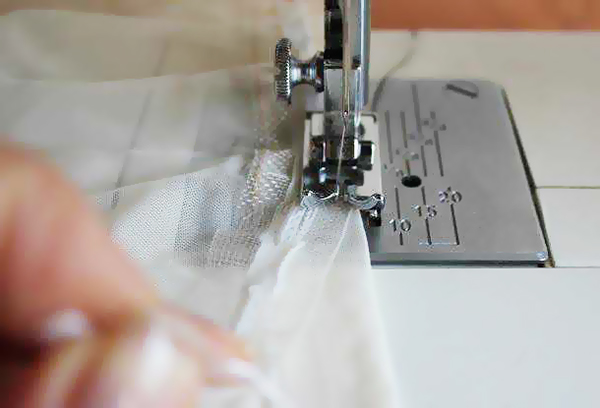
The length of the seams should be kept to a minimum.
Do not secure the thread at the beginning and end of each stitch. After everything is stitched, just tie the ends of the threads tightly. It remains only to connect the curtain tape (braid) with tulle.

How to do this correctly will be discussed in the next section.
Forming folds on the curtains
If you managed to sew the ribbon to the tulle beautifully and correctly, we proceed to the most pleasant stage of the work: the formation of the drapery. We pre-iron the product and tighten the pairs of threads on both sides: this makes it easier to distribute the folds evenly over the entire width of the curtain. If you do not have an assistant, when working on one side, secure a couple of threads at the other end.
VIEW VIDEO INSTRUCTIONS
We do not cut the loose ends of the cords, but carefully rewind them. The curtain will have to be stretched before washing and ironing, so we hide the wound threads under the ribbon or in special bags that professional dressmakers sew on each side.
What are the folds
Since there are several rows of cords on the braid, it will not be difficult to assemble the fabric into beautiful folds with their help. But you need to think about this in advance in order to correctly calculate how much fabric is needed for a particular curtain size.
For example, the gathering factor of the simplest webbing is 1.5. Then, to get a finished product with a width of 3 meters, you need: 3 * 1.5 = 4.5, where 4.5 is the width of the piece of fabric that you need to buy.
The wide belt, in turn, can provide different gathering of the fabric. For example, if you take a braid 10 cm wide, you can, using tightening threads, make folds on the product so that from 5 meters of fabric you get a curtain measuring 2.5 meters. The contraction ratio can be 1: 2, 1: 2.3, or 1: 2.7.
If the coefficient is 2.7, then you need to multiply the length of the finished curtain by this coefficient. The resulting number will correspond to the width of the fabric that you need to buy for such a curtain.
When buying material for a curtain, the braid must be purchased the same length, since it will have to be sewn onto a straight fabric. Sewing a curtain tape on a curtain beautifully is possible only with the help of a sewing machine.
As you can see from the example, the cords on the braid can be pulled together in different ways, then you get a different kind of folds.
- Accordion assembly (normal). This is how you can assemble tulle or thin curtain fabric. The recommended webbing is 6 cm wide and the gathering factor is 1.5. In the finished form, the product will have uniform parallel folds; It can be hung on a string, hooks, or on a thin pipe.
- The assembly of the pencil is classic. The recommended webbing width is 7.5 cm and has three rows of crochet hooks; build factor 2.5. The finished product has narrow vertical folds.
- Large folds are obtained if you use a 9-10 cm braid for the curtain. The gathering factor will be from 2 to 2.7. This braid is used for long curtains or curtains, it has three rows of cords and the same number of lines of pockets.
- The folds that form a triple tuft are called French folds. Recommended tape width 8.5 cm, coefficient 2. The finished product looks gorgeous. Groups of folds are distinguished on it, each of which has three tucks. This method is used for any fabric, the main thing is not to drag the resulting pattern. This curtain tape has two rows of pockets for detachable hooks.
- Double pleated. To get such an assembly, you need a 10 cm wide tape with 4 cords and 2 pockets. Its build ratio is 2.The assembled product has three rows, in which there are thin folds in a checkerboard pattern.
- Counter folds. They can be made either by hand or with curtain tape. It is desirable that its width is up to 7.5 cm, with two rows of pockets for detachable hooks. Coefficient 2.
- Rhombus-shaped folds can also be called differently: waffles, checkerboard, butterfly. A tape with a width of at least 7.5 cm with two rows of pockets for regular hooks will do. Build factor 2.5.
- Box pleat. Recommended tape width 5 cm, with 2 or 4 cords and two rows of pockets. Coefficient 3. It is used for ruffles or short curtains. On long items, this assembly looks a little ridiculous.
It is very easy to sew the braid on the curtains.
But it is also important to correctly calculate the material so that the selected drapery option does not leave the floor of the window without a curtain.

